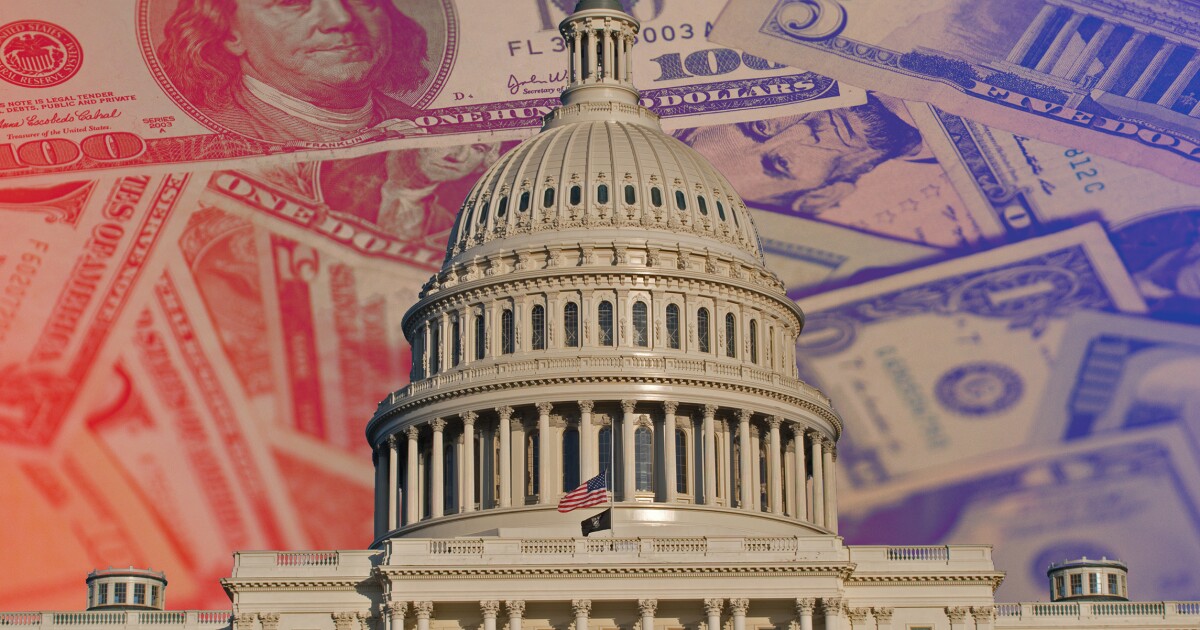

For all of President Joe Biden’s boasting about the deficit reduction that has occurred on his watch, his administration and its allies in Congress are pushing dramatic increases in government spending, even as inflation continues to climb.
“We’re on track to cut the federal deficit by another — another — $1.5 trillion by the end of this fiscal year, the biggest decline in a single year ever in American history,” Biden bragged from the White House last month.
The falling deficit had become a feature of Biden’s economic messaging by this spring, as concerns about the skyrocketing cost of living were beginning to translate into serious doubts, even among some Democrats, about the administration’s ability to manage the economy. Biden presented his deficit reduction as an answer to critics on the Left and Right who had blamed the White House’s spending for driving up prices.
But Biden’s budget claims were misleading at best.
And Democratic appropriators on Capitol Hill are quietly gearing up to spend even more in fiscal year 2023, even though many of their party’s top economists blame Biden administration spending for the inflationary spike.
In February 2021, the nonpartisan Congressional Budget Office projected that the United States would run a deficit of $2.3 trillion for the fiscal year. That analysis, the CBO said, was based on the assumption that the programs in place as of Jan. 12, 2021, when President Donald Trump was still in office, would remain in place throughout the fiscal year.
According to the February 2021 report, CBO analysts did this to calculate “a benchmark that policymakers can use to assess the potential effects of future policy decisions” and not because they expected Biden to leave his predecessor’s policies intact.
“Future legislative action could lead to markedly different outcomes,” the CBO warned.
Fast forward to November 2021, and the CBO’s analysis had changed. After eight months of Democratic leadership, the U.S. had ultimately run a deficit of $2.8 trillion for the fiscal year, meaning Biden oversaw the addition of more than $500 billion to the deficit over what the CBO projected would have been added under Trump.
Biden’s claims about projected deficit reduction for this fiscal year have also been misleading.
That’s because several pandemic-era relief programs expired at the tail end of the last fiscal year and the beginning of this one.
In early September 2021, a trio of federal jobless programs, including one that gave unemployed people an extra chunk of money every week above the standard unemployment insurance rate, expired. In December 2021, so, too, did a popular (among Democrats, at least) child tax credit program.
Biden’s messaging on inflation has been equally misleading, with the potential for even more significant consequences, given that Biden’s refusal to acknowledge the drivers of inflation could lead his party to create more of them.
While Biden continues to blame Russian President Vladimir Putin for his “price hike,” economists from Larry Summers, a former Democratic treasury secretary and National Economic Council chief, to Jason Furman, a top Obama administration economic official, have pointed to Biden’s American Rescue Plan as a culprit for inflation.
Inflationary fears led centrist congressional Democrats to shelve their party’s attempts last year at even more government spending. However, lawmakers managed to push through billions more in the form of an infrastructure bill.
But the looming budget process for the next fiscal year, which begins in just three months, could give Democrats a chance to funnel money toward some of their policy priorities without a contentious intraparty battle.
House Appropriations subcommittees are in the process this month of hammering out draft budgets for different parts of the government, and nearly all propose spending increases for 2023.
One subcommittee drafted a budget in mid-June that would increase spending on financial and general government services by 17%.
Another drafted a budget for the interior and the environment that increased spending by 18%.
Yet another budget draft increased funding for the Transportation and Housing and Urban Development departments by 12%.
Finally, one drafted a budget that would increase funding for the State Department and related agencies by 15% over fiscal year 2022 levels.
Taken together, the draft budgets paint a picture of a party eager to pour more money into an already-overheated economy, despite the warnings that doing so could worsen the situation.
Biden’s budget proposal, which is unlikely to become law in its entirety but offers a window into the White House’s spending priorities, showed boosts in funding for nearly all liberal wish list items; the words “climate change,” for example, appeared 56 times throughout the document.
Although Biden asked in late March for more 2023 funding for nearly every category of government, he did propose a cut to at least one agency: Customs and Border Protection, for which he requested less than Congress had appropriated last year even amid a record-breaking surge of illegal immigration at the border.
However, fiscal conservatives could have the midterm election to thank for complications in the passage of an omnibus spending bill.
Doing so in polarized modern times has become a challenge for Congress even in off years, as lawmakers regularly pass continuing resolutions, or temporary spending bills to buy more time, while they wrestle over budget items.
With inflation and Democrats’ role in sparking it at the center of an election that will take place less than six weeks after the height of appropriations season, lawmakers are likely to punt on a full spending bill until after the votes are in — even as their drafts offer a window into just how much taxpayer money they want to spend.





